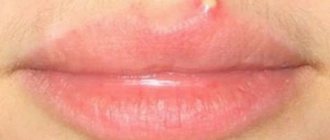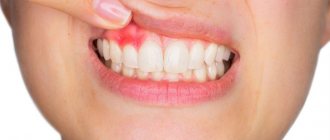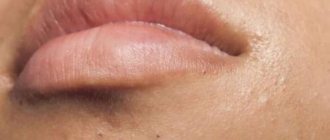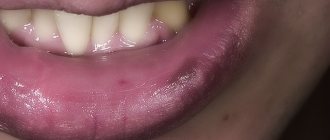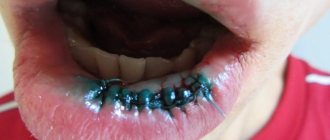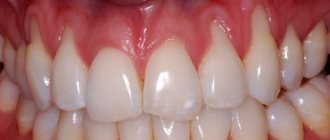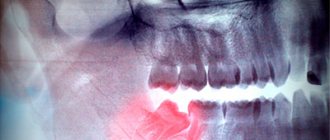Suspect No. 1 – herpes
- Cause. When pimples appear on the lips, the cause may be the activation of the herpes virus, which occurs under the influence of external factors, for example, hypothermia.
- Emergence. Before the rash appears, swelling and pain occur, then severe itching appears, after which vesicular pimples on the lip “ripen.”
- Localization. Most often, herpes is localized along the edges of the lips or in their corners.
- Appearance. With herpes on the lip, pimples resemble vague blisters with liquid. They do not have a specific shape, they are more like spots.
- Quantity. Multiple rashes.
- Feel. Patients with herpes experience burning and itching.
If pimples on the lip turn out to be a manifestation of herpes, doctors prescribe antiviral drugs. This disease should not be left to chance, because after the bubbles burst, the virus spreads along with the leaked liquid, and a new rash appears.
Acne on the face
Acne
Acne
Fungus
Allergy
26008 02 December
IMPORTANT!
The information in this section cannot be used for self-diagnosis and self-treatment.
In case of pain or other exacerbation of the disease, diagnostic tests should be prescribed only by the attending physician. To make a diagnosis and properly prescribe treatment, you should contact your doctor. Acne on the face: causes of appearance, what diseases cause it, diagnosis and treatment methods.
Definition
The sebaceous glands in human skin are located at the base of the hair follicle. They produce sebum, which moisturizes the skin and protects against the negative effects of the environment, bacteria and fungi. Hypersecretion of the sebaceous glands provokes the formation of pimples (acne, blackheads). On the face, they are most often localized in the locations of large sebaceous glands (on the forehead, temples, cheeks, nose and chin).
Types of acne on the face
In its most general form, acne falls into one of two types:
Non-inflammatory elements
(comedones) - look like small tubercles or dots of different colors. Comedones can be open or closed.
- Open comedones look like dense surface-type rashes, usually gray or black in color, which gives them the oxidative reaction of their contents with oxygen.
- Closed comedones, subcutaneous pimples (milia) look like white bumps or dots that look like small grains of millet. Accumulated sebum has no way out, which leads to painful inflammation. Closed comedones often turn into classic red pimples.
Inflammatory elements
are immediately noticeable due to their size. The skin around them becomes thinner and redder, and the purulent contents of the pimple are visible through it. When palpated, painful or uncomfortable sensations usually occur. There are several types of inflammatory rashes:
- Papules (red pimples) are inflamed comedones without obvious purulent content. They look like small red or pink balls protruding above the surface of the skin; there is no white head. If a papule has formed at the site of an open comedone, then a dark plug can often be seen through the skin.
- Pustules are infected papules or, more simply, pimples with purulent contents and a white head, surrounded by inflamed skin.
They appear when, in addition to sebum and bacteria, dead skin cells get into the pores. Pustules are cone-shaped, flat or spherical in shape. Their color can vary from white to yellow or green. Green color means the addition of a secondary infection, and if you squeeze it out on your own, there is a high probability of its penetration into the blood. - Nodules (nodules) are deep, hard subcutaneous papules of bright red, bluish or purple color, ranging in size from 1 to 3 cm, protruding to the surface of the skin, often accompanied by purulent discharge. After recovery, pigment spots and scars are left behind.
- Cystic acne is a sign of damage to the deep layers of the skin, indicating the presence of inflammation with the formation of pus. Cysts located at a short distance from each other tend to merge, forming a whole chain connected by fistulas.
Cystic acne is difficult to treat and always leaves noticeable marks on the skin.
Possible causes of acne on the face
So, acne appears as a result of excess sebum production, which clogs the skin pores. If the pore is partially closed and there is air access into it, acne begins to form. At first they look like blackheads surrounded by inflamed skin - the so-called blackheads. In a completely clogged pore, like in a container, anaerobic bacteria ( Propionibacterium acnes or Malassezia
), provoking the inflammatory process and suppuration.
But what makes the sebaceous glands work so actively? It is believed that one of the reasons lies in the high level of androgens (male sex hormones), which stimulate the production of sebum. The development of hyperandrogenism can be facilitated by digestive problems, stress, diseases of the kidneys and adrenal glands, endocrine and reproductive systems.
It is important to mention that rashes on the face that look like pimples can be a symptom and manifestation of other, sometimes very serious, dermatological diseases (acneiform dermatoses), which are in no way related to the functioning of the sebaceous glands.
Acne on the face can be a symptom of a number of diseases (dysfunction of internal organs, hormonal dysfunction, lack of vitamins, decreased immunity), as well as poor environmental conditions and improper skin care. We list the main diseases, conditions and factors that result in skin rashes.
- Physiological changes in hormonal status: puberty, second phase of the menstrual cycle, pregnancy, lactation, menopause.
- Diseases of the endocrine system: polycystic ovary syndrome, hypothyroidism, tumors of the endocrine glands.
- Thickening of the stratum corneum of the epidermis (hyperkeratosis), when dead cells of the epidermis are not exfoliated, but remain on the skin, clogging the sebaceous glands.
- Liver diseases and intoxication caused by them.
- Poor nutrition and vitamin deficiency:
- The predominance of fast carbohydrates (fast food, baked goods, fried, fatty foods) in the diet provokes an increase in blood glucose levels and a sharp release of insulin, which, in turn, affects the increase in testosterone levels.
- Excess omega-6 fatty acids can aggravate inflammatory processes in the skin (such phenomena can be observed when consuming large amounts of fish and poultry raised on animal feed).
- Abuse of dairy products, sunflower, peanut, soybean oils and margarine often causes hyperfunction of the sebaceous glands.
- Deficiency of zinc, vitamins A and E, Omega-3 fatty acids.
) also play a certain role in the formation of acne and, if not their direct cause, then certainly complicate treatment.
Which doctors should you contact if acne appears on your face?
If you have skin rashes, you should consult a dermatologist and cosmetologist. However, treatment often requires an integrated approach, which involves treating the disease of which acne is a symptom. In this case, consultations with a neuropsychiatrist are necessary.
Diagnostics and examinations for the appearance of acne
Pimples and their localization are a kind of messenger that transmits information about disruptions in the functioning of organs or systems. Most often, acne occurs in the so-called T-zone (forehead, nose, chin) - here the sebaceous glands are most active and the pores are enlarged. But acne is often found on the cheeks and cheekbones (U-zone). This is due to various reasons and the state of the body. A special guide map “Types of acne and what they mean” has been compiled. Thus, the middle part of the forehead corresponds to the lower part of the digestive tract, the small intestine and the bladder, the area near the ears - to the kidneys, the eyelids and the area around the eyes - to the liver, the temporal region - to the gallbladder, the middle third of the face, cheekbones - to the lungs, chin - to the stomach, the pelvic organs, the nose - the pancreas and heart, and the lower part of the cheeks and lower jaw - the lower gastrointestinal tract.
Diagnosis begins with a thorough examination of the skin, collecting anamnesis (information about past illnesses, operations, chronic diseases, heredity) and establishing a connection between the rashes and lifestyle, nutrition, and habits.
If the nature of the disease is not obvious, laboratory tests are prescribed.
- Clinical blood test.
Suspect No. 2 – acne
- Cause. Acne is a multifactorial disease. The main links in its pathogenesis are hyperkeratosis, excessive sebum production, colonization of propionibacteria, and inflammation. For example, if a small whitehead appears on the lip, a blockage of the sebaceous gland could occur, leading to the formation of a closed comedon.
- Emergence. Acne usually appears suddenly.
- Localization. With acne, pimples rarely appear on the lip, since there are few sebaceous glands in this area. Most of them are in the so-called seborrheic zone - the nose, forehead, chin, this is where acne occurs most often.
- Spring view. A slight swelling of red color; if a purulent pimple has formed on the lip, then a white head can be seen inside, the acne takes a cone-shaped shape.
- Quantity. Most often they pop out one at a time. In severe cases of acne, they may merge.
- Feel. Papules and pustules may be painful, especially when palpated.
After opening, the acne fades, so many people think that this is a great way to get rid of them, but this approach can lead to aggravation of the problem, an even greater spread of the rash.
What should you not do if you have a pimple on your lip?
When a pimple appears on your lip, the first thing that comes to mind is to squeeze it out, treat it with alcohol to dry it, or with a wound-healing ointment that you have lying around in your medicine cabinet. This is strictly forbidden. If the rash on your lips is herpes, squeezing it can only lead to more spread of the virus. Not every ointment (cream, gel or solution) is suitable for combating rashes. Here's what else you can't do if a purulent pimple appears on your lip:
- Use lipstick or balm. It is recommended to change lip product every 2 months, as bacteria and other pathogenic microorganisms accumulate on it.
- Use alcohol solutions if the rash is on the inside of the lip. Alcohol can burn the mucous membranes.
- Use peelings. Wherever the rash appears, it should not be treated with abrasive particles. So, for acne, peelings are used only during remission of the disease.
How to deal with acne?
Treatment for acne depends on the severity of the disease. It is prescribed exclusively by a specialist. For mild to moderate acne, external therapy is primarily used18. For severe acne, emphasis is placed on systemic treatment18.
Clindovit® is a topical antibiotic that can be prescribed for acne vulgaris6. The main active ingredient in its composition is the antibiotic lincosamide clindamycin6. It fights a wide range of propionibacteria strains6. After contact with the skin, clindamycin quickly accumulates in comedones, exhibiting antimicrobial activity6. Clindovit® gel helps reduce free fatty acids on the skin6.
The drug must be applied twice a day (morning and evening) to previously cleansed and dry skin. The first results from treatment with a topical antibiotic usually become noticeable after 6-8 weeks. It is recommended to combine the use of the drug with the use of benzoyl peroxide or azelaic acid (Azelik® gel)18,28.
Causes of acne around the mouth
Not all experts agree that this is a disease on its own. Some associate it with allergic and seborrheic dermatitis. Those who are inclined to believe that the disease is independent also call it perioral and steroid dermatitis. This disease affects women and girls aged 18 years and older. Cases of the disease in children and men are rare. The exact provocateurs have not yet been discovered, but there are a number of reasons contributing to the development of the disease. Basically, this is a weakening of the body’s protective functions, which occurs due to the influence of external factors and internal problems in the body.
Homemade beauty recipes
They have existed since ancient times. Among them there are those that help get rid of unpleasant rashes. Many of them are harmless and do not require consultation with a specialist, but it is still better not to self-medicate.
So, knowing why pimples appear or have already appeared in the chin area, you can use the following safe methods to eliminate them:
- Using aloe juice. This plant is known for its bactericidal effects. Nectar is used in its pure form to wipe problem areas or in combination with other ingredients. Its leaves can be stored in the refrigerator.
- Cucumber masks. Cucumber juice tones and helps tighten pores. Lotions are often made from grated vegetables. To do this, pour boiling water over the pulp and leave for three hours.
- Soda. If rashes do not appear due to demodex, then you can use a lotion based on this product. To do this, soda is mixed with sugar and dissolved in warm water.
Why do acne appear on the chin in women and men?
Many of these factors apply equally to everyone, but there are also those to which representatives of a particular gender are more susceptible. This is primarily due to the hormonal sphere and anatomical features of organisms. Many processes in the body occur in different ways. Let's look at the main problems.
Causes of occurrence in women
The most common situation is the approaching period. During this period, hormonal changes occur that affect sebum secretion. Gynecological diseases are also the troubles why a lot of acne appears on the chin of girls and women. Increased secretion of male hormones in the female body or hyperandrogenism also leads to acne.
Cosmetics can also be a problem. Of course, representatives of the stronger half also take care of themselves and strive to be beautiful, but this topic is still closer to the female sex. Poor quality makeup, expired or incorrectly selected creams negatively affect the condition of the skin.
Occurrence in men
Hyperandrogenism can cause acne and excess subcutaneous fat. Frequent shaving and the use of dull blades also contribute to irritation. Acne on the chin can appear in male athletes, the reasons lie in the use of any drugs - steroids or glucocorticoids.
